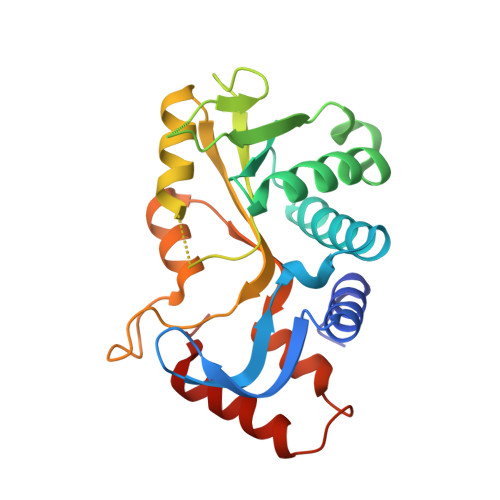Ternary complex formation and induced asymmetry in orotate phosphoribosyltransferase.
Gonzalez-Segura, L., Witte, J.F., McClard, R.W., Hurley, T.D.(2007) Biochemistry 46: 14075-14086
- PubMed: 18020427
- DOI: https://doi.org/10.1021/bi701023z
- Primary Citation of Related Structures:
2PRY, 2PRZ, 2PS1 - PubMed Abstract:
Orotate phosphoribosyltransferase (OPRTase, EC 2.4.2.10) catalyzes the Mg2+-dependent condensation of orotic acid (OA) with PRPP (5-alpha-d-phosphorylribose 1-diphosphate) to yield diphosphate (PPi) and the nucleotide OMP (orotidine 5'-monophosphate). We have determined the structures of three forms of Saccharomyces cerevisiae OPRTase representing different structural and enzymatic intermediates. The structures include the apoenzyme (2.35 A resolution); a ternary complex of enzyme, Mg2+-PRPP, and OA (1.74 A resolution); and the binary product complex of enzyme with OMP (1.89 A resolution). While the overall structure of the S. cerevisiae OPRTase is similar to that of the Salmonella typhimurium enzyme, as judged by comparison of the two apoenzymes, large conformational transitions occur proceeding from the apoenzyme structure to those of the substrate and product complexes. Comparison of these structures reveals a rotation of the upper hood domain onto the bound ligands by an average of 19.5 degrees in the OMP structure and an average of 24.6 degrees in the OA/Mg2+-PRPP ternary complex. As expected, the conserved loop, composed of residues 104-116, moves extensively and adopts a single stable conformation during the catalytic cycle in order to sequester the substrates from bulk solvent in the ternary complex. The OA and Mg2+-PRPP molecules bound in the ternary complex are oriented for proper attack of the N1 atom of OA onto the C1 atom of the ribose ring. This orientation of substrates, combined with the positioning of the flexible loop, provides a clear picture of a catalytically poised reaction complex for type I phosphoribosyltransferases. The structural asymmetry present in these structures, as well as that found in a recent structure of the S. typhimurium enzyme, combined with the closure of the flexible loop from one subunit into the active site of the opposing subunit in the ternary complex is consistent with the kinetic data [McClard, R. W., et al. (2006) Biochemistry 45, 5330-5342] that demonstrate induced nonequivalence and cooperativity of OPRTase.
Organizational Affiliation:
Department of Biochemistry and Molecular Biology, Indiana University School of Medicine, Indianapolis, Indiana 46202, USA.















